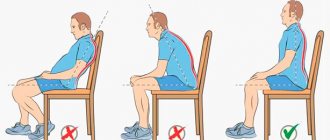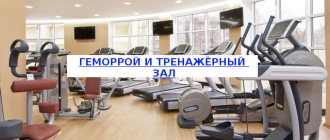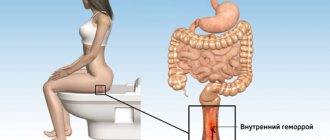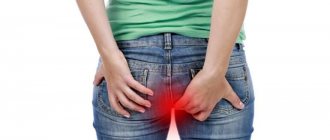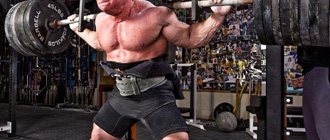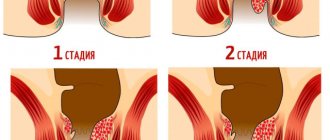But physical inactivity, chronic constipation and lack of fluid in the body are the main reasons for the development of hemorrhoids.
Hemorrhoids are a pathological expansion of the veins of the anal canal due to stagnation of blood in this area, as well as a violation of the inflow-outflow ratio. The disease begins with discomfort in the rectal area during bowel movements, pain, itching and burning in the anus. As the pathology progresses, the nodes begin to extend beyond the sphincter. This can provoke bleeding, strangulation of the node and its thrombosis. The complications of this disease are severe and require serious hospital treatment, as well as the help of specialists.
What are the benefits of exercise for hemorrhoids?
Hemorrhoids are a saccular expansion of the veins of the rectum (internal version) and the anal area (external version). It develops due to a prolonged increase in intra-abdominal pressure and causes pain, bleeding, pinched hemorrhoids, and the appearance of very painful, bleeding fissures in the anal area. Often the development of complications dictates the need for surgical treatment.
In advanced cases, adequate physical activity and physical therapy for hemorrhoids will no longer give the desired effect, but in the early stages they will help solve a number of problems:
- Prevent the formation of blood clots in the nodes of hemorrhoids and anal canal fissures;
- Stimulate blood flow in the venous system of the pelvic organs;
- Slow down the progression of the disease;
- Normalize intestinal motility and prevent constipation;
- Help relieve gases;
- Strengthen the muscle diaphragm of the perineum;
- Provide a general tonic effect on the body.
Rules and recommendations
The first rule is a mandatory preliminary consultation with your doctor. You should approach any physical activity carefully, listening to your body and not trying to break any “records”.
If pain or other unpleasant symptoms appear during exercise, the exercise should be stopped immediately.
For hemorrhoids, cardio exercise is good because it strengthens the cardiovascular system, tightens the muscles and does not involve strong tension in the abdominal muscles. This includes: swimming, walking, light jogging, skiing.
Read more about the benefits of swimming for men, women and children, about this type of walking such as Nordic walking, and about running: shuttle, short and long distances.
When practicing, you need to follow the following rules:
- Avoid any stress that leads to pain in the anal area.
- Start with a light load, increasing it gradually.
- Exercise smoothly, without jumps.
- Do not hold your breath so as not to increase the pressure in the abdominal cavity.
Contraindications for gymnastics
Physical activity is not always allowed for patients with hemorrhoids. Contraindications to training are:
- Heavy bleeding;
- Early postoperative period;
- Malignant neoplasms;
- Increased intracranial pressure;
- Exacerbation of spinal diseases;
- Complicated pregnancy, threat of miscarriage.
Many of these contraindications are relative. The question of the possibility of training is decided in each case individually, depending on the existing symptoms, concomitant diseases and prescribed medications.
Note!
Exercises for hemorrhoids during the period of exacerbation of the process can only be done with the permission of the attending physician, who will explain which exercises are allowed for varying degrees of severity of the disease.
The following types of physical activity are contraindicated for hemorrhoids of any stage:
- Power training;
- Exercise bike exercises;
- Weight lifting;
- Any abdominal exercises;
- Sharp swinging movements of the legs;
- Deep squats.
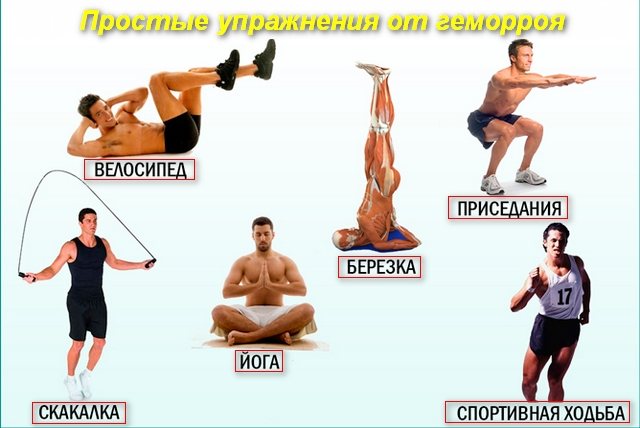
Hemorrhoids and physical activity
Many people with hemorrhoids mistakenly think that they are prohibited from any physical activity, but this is absolutely not true. Naturally, if during the onset of an exacerbation the doctor prescribes strict bed rest, then we are not talking about exercises.
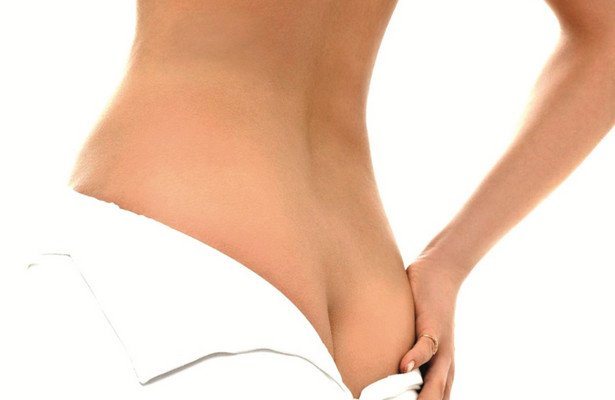
However, during remission, exercise is not only acceptable, but also necessary. And even when coming out of an acute period, simple walking or a little exercise will only be beneficial. All this is aimed at restoring normal blood circulation in the pelvis, preventing blood stagnation and improving muscle tone.
Did you know? The first time hemorrhoids are mentioned is in the works of the famous scientist Hippocrates. In Rus', the name “royal disease” was assigned to this disease.
»
. Probably the reason for this was the sedentary lifestyle of the nobility and, accordingly, the widespread prevalence of hemorrhoids among them.
The best exercises for hemorrhoids
Gymnastics for hemorrhoids at home includes complexes using the Bubnovsky, Norbekov, Kegel methods, yoga and other activities that strengthen the muscles of the perineum. You should start exercise therapy as early as possible, as soon as hemorrhoids first appear.
During training you need to follow some rules:
- It is better to conduct classes after bowel movements;
- You need to increase the load and duration of training gradually;
- It is important to avoid sudden, jerky movements when performing gymnastic elements;
- Do not interrupt your breathing while inhaling;
- The exercise time should not be less than 10 minutes per day;
- In case of exacerbation of the disease, before starting exercise therapy, you need to use a drug with a local anesthetic;
- It is necessary to listen sensitively to how you feel and avoid exercises that cause persistent discomfort.
Important!
Exercises after hemorrhoid removal are always selected individually. It is prohibited to start training in the first 2 weeks after surgical treatment.
Kegel exercises for hemorrhoids
This exercise therapy was developed by an American gynecologist specifically for pregnant women to facilitate recovery after childbirth and combat urinary incontinence. However, it later turned out that in some situations, gymnastics is also useful for men. In particular, it helps to effectively fight hemorrhoids.
- Sit comfortably, lying on your back. Relax. Tighten the muscles of the pelvic diaphragm: feel how the anus “retracts” deep into the rectum. Freeze in tension for 3 seconds, then relax. Gradually, the period of muscle contraction should lengthen more and more, reaching 1 minute. The exercise can also be performed sitting, standing, in public places - no one will notice anything anyway.
- We perform an exercise similar to the previous one, only now there is no need to delay the period of tension. On the contrary, it is necessary to increase the speed between tension and relaxation.
- Take a knee-elbow position, rest your head freely on your hands. Contract the muscles of the perineum again, directing it inward and upward.
- Lie on your stomach, place your arms under your head with your elbows out to the sides. Bend one leg slightly and slightly pull your knee towards your elbow, leaving it in a relaxed state. We again strain the muscles of the perineum, holding it in a contracted state for several seconds.
- Stop the flow of urine for a few seconds while urinating.
We perform all exercises 8-10 times.

Yoga in the treatment of hemorrhoids
Elements of yoga allow you to achieve effective outflow of venous blood from the pelvic organs, preventing its stagnation and thrombus formation in hemorrhoids, and also normalize the functioning of the digestive tract. It is required to perform 12 approaches.
- A tree bending in the wind. Stand straight, straight forward, big toes together, heels slightly apart. As you exhale, bend to the right, freezing in this position for a couple of seconds. As we inhale, we straighten up. Then we lean to the left in the same way. Only the upper part of the body should bend, the pelvis remains motionless.
- Mountain. From the previous starting position, stretch up as much as possible, tense your knees, buttocks, and pull in your stomach. We raise our hands up, palms inward. We stand on tiptoes and freeze like that for half a minute.
- Cobra turn. We spread our feet 30 cm apart and rise on tiptoes. We turn our upper body as much as possible so that we can see the heel of the opposite leg. We return to the starting position and repeat in the other direction.
- Abdominal massage. We squat down, place our palms on our knees. We turn to the right, tilting the opposite knee to the floor, then vice versa. We twist the body as much as possible, trying to look behind ourselves.
- Root system. An exercise similar to the Kegel technique. It is necessary to strain all the muscles of the pelvic floor from bottom to top, and then relax in the opposite direction: from top to bottom.
Principles of classes
Exercise against hemorrhoids will take no more than 30 minutes a day. Morning exercises will not only help you overcome hemorrhoids, but will also give you strength for the whole day, help you feel great and maintain a beautiful figure. When choosing a set of exercises for exercise, you can consult a proctologist or sports doctor. Regardless of the stage of hemorrhoids and your individual characteristics, all activities you choose must meet certain requirements:
- when starting to exercise, you need to start with small loads, gradually increasing the intensity of the training;
- air retention must be prevented;
- all exercises should be carried out without jerking, smoothly;
- from the list of exercises you will have to exclude those that can cause even minimal pain in the anorectal area, based on your subjective sensations.
Useful video - Several easy exercises to quickly get rid of hemorrhoids
Norbekov method
M. Norbekov proposed a gymnastic complex for the treatment of diseases of the spine, but many of its elements also help well with hemorrhoids. A set of exercises for the sacrum and coccyx is especially effective: it can improve blood circulation in the pelvic organs and slow down the development of the disease.
- Place your feet the width of your shoulder joints and lower yourself into a half-squat. We bend in the lower back, as if trying to stretch the tailbone upward, towards the back of the head.
- Now from the previous position we move the pelvis forward, stretching the tailbone towards the forehead. The upper parts of the body remain motionless.
- Straighten your legs, tilt your body forward at an angle of 45 degrees, bending at the hip joints. We bend the spine again, pulling the tailbone towards the back of the head.
- Remaining in the same position, we step from one foot to the other several times.
- While standing, we move our hips in a circle: several circles in one direction, then a few more in the opposite direction.
- With our feet shoulder-width apart, we shift our weight to our right leg and make several springy movements with our hips in the same direction, as if trying to push our leg further and stretching our right side. The hand of the same name is extended upward. We repeat everything on the other leg.
Do everything 9-10 times.
Doctor Bubnovsky: exercises for hemorrhoids
Dr. S. M. Bubnovsky proposed a method of exercise therapy that compensates for an inactive lifestyle and helps avoid dilation of hemorrhoidal vessels. Against the background of systematic implementation of these elements, both external and internal hemorrhoids disappear.
- Standing on all fours, alternately arch your back “like a cat,” then up as you inhale, then down as you exhale.
- Leaning on your palms and knees, rock your body back and forth.
- Leave your feet on your knees, lower your hands to your elbows. As you inhale, we get as close to the floor as possible, and as you exhale, we sit down with our buttocks on our heels.
- We lie loosely on our backs, stretching our arms along the body. As you inhale, lift your pelvis upward, lifting it off the floor. As you exhale, we return it back.
- In the same position, we clasp our hands at the back of the head, touching the chest with our chin. We reach our elbows with bent legs. This is the safest abdominal exercise for hemorrhoids.
- We perform the “scissors” exercise, alternately crossing our legs in the horizontal and vertical planes.
- We roll over onto our stomachs. As you inhale, stretch your straightened arms and legs upward. We relax together with the exhalation.
8-10 repetitions are enough.
About the benefits of physical activity
The introduction of various devices into our daily lives that eliminate housework has led to physical inactivity. A person begins to move less, and this is a direct path to the development of pathologies in the pelvic organs. Insufficient blood circulation causes stretching and prolapse of nodes, as well as congestion in the muscles of the rectum.
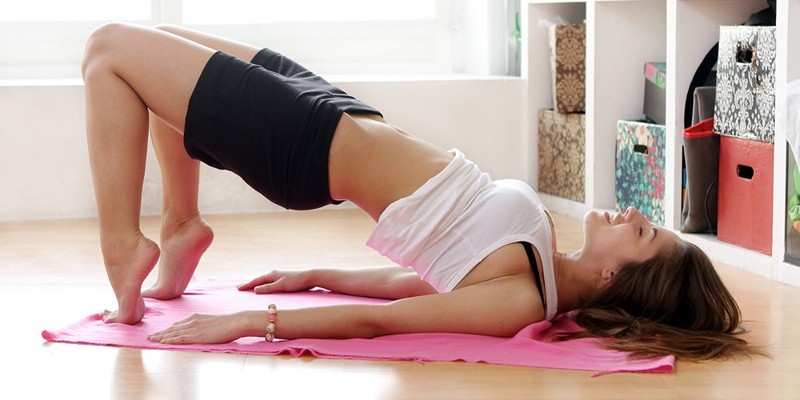
Ignoring the first symptoms leads to the growth of vascular pockets (bumps), which often become inflamed and bleed. The clinical picture is accompanied by acute pain, the patient suffers throughout the day. Often, hemorrhoids occur against the background of chronic constipation, and defecation turns into a real ordeal. Weak intestinal motility leads to stagnation of feces and intoxication of the entire body.
First of all, you need to remember that ordinary laxatives cannot solve the problem. It is necessary to improve your diet by including fiber-rich foods in your diet. This substance stimulates the gastrointestinal tract, removes toxins, and cleanses the intestines. But not only the right food helps eliminate the problem, physical activity helps to cope with constipation.

We recommend reading: How to take furadonin for cystitis before or after meals - diagnosis and treatment, treatment methods, nutrition, signs of the disease
Hemorrhoids are not an obstacle to sports, as some patients incorrectly believe. The main thing is that the selection of exercises is carried out by an experienced specialist and takes into account the degree of development of the disease. If gymnastics is done in between exacerbations, it significantly improves the patient’s condition, as evidenced by many years of practice.
- Exercises must be done as described and systematically.
- The complex lasts for 10-15 minutes.
- Start gymnastics only after defecation.
- Before classes, you need to lubricate the knots and cracks with ointment to prevent pain. You can take a warm bath, this will help relax your muscles and not feel pain.
Prevention of hemorrhoids
Prevention of hemorrhoids is especially important for people leading a sedentary, sedentary lifestyle. If hemorrhoids have already formed, then it is important to prevent the progression of the process and the development of complications. Preventive measures include the following:
- Following a diet high in vegetables and fruits, combating constipation;
- Refusal of alcoholic beverages;
- Exercise therapy at home, simple warm-ups at work;
- Using soft toilet paper or wet wipes;
- Wearing soft, loose underwear made from natural fabrics;
- Warm baths with sage, chamomile, oak bark;
- Washing with cool water after defecation;
- A course of venotonics as recommended by a doctor (detralex, antistax, troxerutin);
- Use laxatives as rarely as possible.
Under any circumstances, you need to take adequate care of your health. If the doctor recommended the use of ointments, suppositories, tablets, then you should not refuse them. It should also be understood that in some cases the only option is surgical correction. Gymnastics should complement, and not replace, hemorrhoid therapy prescribed by a doctor.
Features of the Kegel technique
Surely many have heard about exercises for the perineal muscles, invented by the gynecologist Kegel. But not everyone knows that they are useful not only for women. These simple and effective exercises help strengthen the pelvic floor, the walls and veins of the rectum, the muscles of the buttocks and anal sphincter, and help the outflow of blood.
They should be performed daily, excluding times of exacerbation of the disease with loss of cones and bleeding. Regular exercise will reduce the manifestations of hemorrhoids, reduce the volume of nodes and the frequency of relapses of the disease.
To begin with, it is better to perform the exercises in a lying position. This will make it easier to learn how to tense the desired muscle group without affecting the rest. It is important to get a feel for the correct technique: it resembles an attempt to delay bowel movements or stop urination.
Starting position: lying on your back with your knees bent. Tighten your muscles, feeling the sphincter contract and draw inside the anus. Freeze for three seconds, then relax. The duration of tension can be gradually increased while maintaining the same period of relaxation.
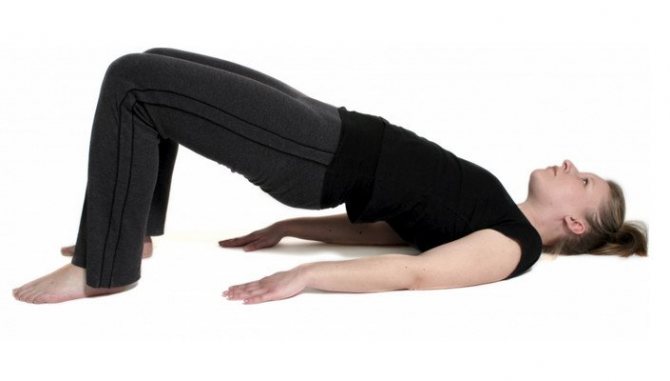
Exercise four times a day for ten approaches. Once you master the exercise, you can do it sitting or standing, which will allow you to practice at any time. Later you can modify it by changing the duration and frequency of contractions or the force of retraction.
Video: how to do Kegel exercises
Important! Chronic constipation has an extremely adverse effect on the condition of the anal veins. Healthy intestinal motility is an indispensable condition for the treatment and prevention of hemorrhoids.
How to do
Exercise for hemorrhoids is aimed at strengthening and increasing the elasticity of the walls of the vessels of the anus, preventing blood stagnation in the pelvis, strengthening the abdominal, gluteal, and perineal muscles.
Treatment of hemorrhoids by exercise refers to traditional medicine methods and includes the following useful exercises:
- Compression and relaxation of the muscles of the anal area. Perform three sets of 10 times. The exercise is the simplest and most accessible - you can perform it anywhere and absolutely not noticeable to others.
- "Bike". Performed in a supine position, you need to pedal an imaginary bicycle for several minutes.
- "Scissors". Without changing the starting position, alternately cross your slightly raised, straight legs. Allows you not only to get rid of hemorrhoids, but also to pump up beautiful lower abs.
- "Kitty." In a position on all fours, round your back for a count of one to four, and bend your lower back down for a count of five to eight.
- "Dog". Standing on all fours, rest your elbows on the floor, alternately straighten your arms and legs, holding for 3-5 seconds.
- "Birch". Lying on your back, rest your elbows on the floor, raise your straightened legs up, slowly lifting your pelvis. Keep the “birch tree” for as long as possible.
- "Curve." In a lying position with your arms extended along your body, slowly lift your pelvis from the floor, squeezing your buttocks and hold for 3-5 seconds.
- "Circle". Lying on your back, lift one leg up and make circular movements. Five movements clockwise and counterclockwise. Do the same with the second leg.
- "Bridge". Lying on your back, place your heels in the buttocks, legs bent at the knees, palms along the body. Tightening your leg muscles, slowly raise your pelvis until your back arches, straightening your legs as much as possible, hold for 5-7 seconds and slowly return to the starting position.
- Moving on the buttocks. Sitting on the floor, straighten your back. Straining your buttocks one by one, move them forward. The legs remain inactive. Five minutes of this movement is enough.
Exercises are not contraindicated at any age; their implementation does not depend on physical fitness. The best effect will be achieved by combining exercise and cardio exercises - jogging, intense walking.
When performed systematically, yoga and Kegel exercises also bring good results.


